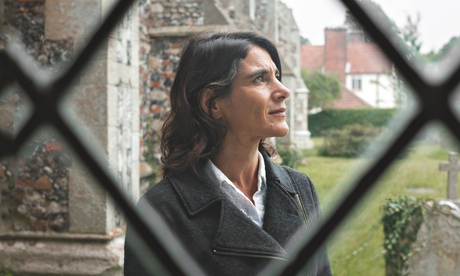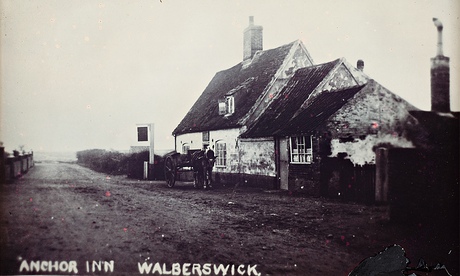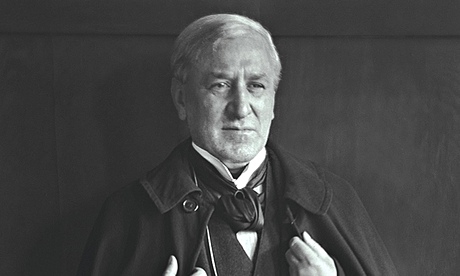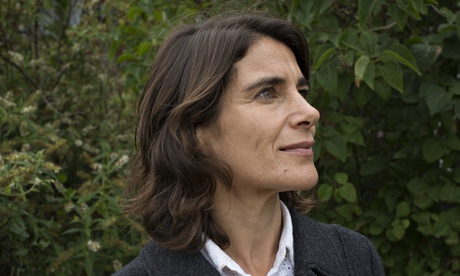Esther Freud: my house's ghosts inspired my new book
Fifteen years ago, Esther Freud bought a strange cottage in a sleepy seaside Suffolk village. She acquired all its contents, too, but they weren't the only things she'd inherited…
Esther FreudThe Guardian, Saturday 16 August 2014


Esther Freud: 'A shadowy presence hovered by the back door. I knew it was a boy of about 10 or 12, in short trousers.' Photograph: Eva Vermandel for the Guardian
About 15 years ago, we bought a cottage in the Suffolk village of Walberswick. It was a village I had been visiting for years. My father's parents had migrated there when they arrived in Britain from Germany in the 1930s, and although I never knew them (my father, Lucian, was rebellious and private, to the extent that he preferred not to introduce his children to his parents), I had rebelled in my own way by being sentimental and nostalgic, and by loving many of the things he spurned.
"It's a dreary place," he'd told me when I complained about needing to get out of London, "but you might enjoy it for a day or two." That was 30 years ago, and since then there has rarely been a month when I haven't driven east, cheering as I pass the Suffolk sign, my heart swelling as I veer off down the narrow road towards the sea.
The house we bought belonged to an elderly Jewish couple. They had bought it themselves from a cousin of my father's – a man they met in an internment camp on the Isle of Man, and with whom they had remained friends. Before that, it had belonged to another refugee, a psychoanalyst from Vienna – and now this couple were eager to keep the house "in the family", as they considered us Freuds.
I was grateful, even though one of their seemingly eccentric requirements was that they leave everything in the house. Once we moved in, we discovered that this meant everything. Tea towels folded in the drawer. Potato masher on its peg. A sewing box complete with rusted pins. Sheets, pillowcases, pictures, books. Each item was labelled – and not only by them, but by the previous owners, and those before them. A house full of objects, labelled back to 1949. "Amethyst". A sticker clung to the felt base of a rock. "Low beam". The words jumped as you hit your head. My favourite: "Spare key for spare room telephone", followed closely by another favourite, a label rolled into a jug: "Does not pour very well".
The house also came with a history. This comprised a dozen typed pages and detailed the fact that, until the 1920s, this cottage had been the village inn. As such, it had endured much turmoil. In 1787, the family who ran it were described as having eight sons, two surviving, three daughters, one surviving; in 1824, John Banks, the licensee, had fallen into a well on his way home from Wickham Market and drowned. His youngest child was two and a half months old, and not long after there was an auction of his widow's effects out on the street. This was nothing compared to the tragic era of the next landlord, a Mr William Easy, whose daughter drowned herself in the rainwater tub and not long after, "very singular, her grandmother, relict of Mr Francis Robinson of W – did then and there on the 20.9.1842 drown herself in a Rain Water Tub also." She was 80.
You can imagine how relieved I was to read that, in 1927, a new pub was built to accommodate the increasing number of visitors to the coast, and that the original building had been dismantled and taken by wheelbarrow, bit by bit, to a new spot at the top of the village. But before it was moved, a distinguished visitor had lodged there – the architect Charles Rennie Mackintosh. Mackintosh had come to Walberswick in 1914, and stayed a year, painting a series of watercolours of flowers. At some point he had taken a room at the inn – the best bedroom, I imagined – and as I sat on the inherited bed (sheet and pillowcase embroidered with a past resident's name), I pictured him sitting where I sat, putting the finishing touches to the delicate petals of a larkspur. Later I found an article about him in a shoe box ("newspaper clippings"). I learned that even though Mackintosh had died in London in 1928, penniless and forgotten, his fame had slowly risen since so that his work was fetching vast sums at auction. I looked with new interest at the prints and sketches on the walls. There were pictures of boats, of bathers on the beach, of our house before and after it was the village pub. There was even a strand of edelweiss pressed into a gilt frame. But hard as I searched, there was nothing that could be attributed to Mackintosh, except a postcard in a clipframe. Fritillaria, 1915, with his and his wife's initials drawn in a rectangular box.
 Charles Rennie Mackintosh’s time in the village was fraught with danger and anxiety
Charles Rennie Mackintosh’s time in the village was fraught with danger and anxiety
There was something else in the house, unmentioned and unlabelled. A sort of shadowy presence that hovered by the back door. No one referred to it, so I kept quiet, but without ever really actually seeing anything I knew it was a boy. A boy of about 10 or 12, in short trousers and a cap. I acknowledged him as I walked by, much as I would acknowledge a single magpie, with a dip of the head and a murmured incantation. "I know you're there," I'd say under my breath. "It's all right, I know you're there." I imagined he had somehow come with the house from its old site, that he was one of those surviving brothers. Or a boy from the family of the girl who drowned. He was sad, and proprietorial, had one lame leg, and although he didn't wish me any ill, I accepted he had been there a lot longer than me.
I always knew I would write something about the house. There was the wheelbarrow, the labels, the ghost, Charles Rennie Mackintosh – and so I chose a young woman narrator, recently moved to the country with her children, and tried through her to draw all this together. God, it was dull. The house needed renovating. The children's behaviour was repetitive and tiresome. The ghost failed to be frightening. And Charles Rennie Mackintosh, in his cloak and deerstalker hat, had the smallest of walk-on parts. Then one day, I changed tack. I needed a break from the harried young mother, and I gave my ghost a voice.
My name is Thomas Maggs, I wrote. I was born upstairs in the small bedroom, not in the smallest room with the outshot window, where I sleep now, or the main room that is kept for guests... My skin prickled. I had him, and I knew right then it would be through this boy – my boy – that I'd tell the story. I would tell Mackintosh's story, too. I am the youngest son of William and Mary Maggs, and the only son surviving.
I knew little about Charles Rennie Mackintosh then, and had no idea that he was also the only surviving son of a large family, surrounded by sisters and the ghosts of dead brothers, or that, like Thomas, he walked with a limp. All I really knew was that Mackintosh had designed the Glasgow School of Art – but as I started to look into what had brought him to Suffolk, I discovered what a difficult and frustrating life he had led, and that his time in this sleepy seaside village had been fraught with danger and anxiety.
Mackintosh was born in Glasgow in 1868, the son of a police clerk who worked his way up through the ranks to superintendent. As a boy he had been precociously gifted, inspired by nature, dragging driftwood and flowers home from walks, drawing and painting them in the basement of his home. At 17 he was apprenticed to an architect – it was too uncertain a future to risk becoming an artist – but his boss had released him on certain afternoons to attend drawing classes at Glasgow School of Art, housed as it was then in cramped rooms in Sauchiehall Street.
 'Mackintosh took to going on long walks, often at night, wandering through marshes, striding along the beach, standing at the water’s edge, his feet in the waves, staring across the sea towards the enemy.’ Photograph: EO Hoppé/Corbis
'Mackintosh took to going on long walks, often at night, wandering through marshes, striding along the beach, standing at the water’s edge, his feet in the waves, staring across the sea towards the enemy.’ Photograph: EO Hoppé/Corbis
Soon he was entering competitions, winning prizes, attracting the attention of the director of the school. It was this man, Francis Newbery, who was instrumental in convincing the city of Glasgow that it should have its own purpose-built art school, and it was also Newbery who encouraged the young Mackintosh to submit plans. Initially, the building went up under the name of the architectural firm Honeyman and Keppie, and in 1899 when the first half of the school opened, with much fanfare and many speeches, not one of them mentioned Mackintosh. Nor was he invited to the opening dinner – although he was there in every panel of glass, every door handle, in the design of the canteen forks. "I hope for brighter days when I can claim my work as my own," he told a friend.
By the time the money was raised to complete the building, Mackintosh was at the height of his powers. He revised and extended his original plans for the art school, much to the consternation of the building committee, who pleaded with him to keep the contract Always Before Him.
But Mackintosh had been finding it increasingly difficult to accommodate his clients' small-minded views, their interference. After bouts of all-night drawing, a bottle of whisky by his side, he would be discovered under his desk by the cleaners. It can't have helped that there had been an understanding that he was to marry John Keppie's sister, but instead he had married a fellow Glasgow School of Art student, Margaret Macdonald. "She has genius where I have only talent," he said about her. Together they created a showcase for their ideas, using their own home, white walls and carpet, white furniture, interspersed with black, and Mackintosh's trademark glass panels in cerise and blue.
Once the art school was finished and finally acknowledged as being designed by Mackintosh, his career began to falter. It didn't help that Glasgow was hit by economic hardship, and that work coming to the firm was cut. But it was more than this. Much as the art school is treasured now – there was an outpouring of grief this year when it was damaged by fire – in 1909 the finished building was met with hostility, one newspaper asking why a house of correction should have been allowed to be built right there in the centre of the city, another proposing Mackintosh be taken out to have his bare arse whipped.
He left Honeyman and Keppie and set up on his own, but work was scarce and he fell ill with nervous exhaustion and pneumonia. On the advice of a friend, he and Margaret packed up their belongings and in the early summer of 1914 they set off for Suffolk, but they had only been there a matter of weeks when war broke out. The summer visitors fled – this coastline is the most easterly point of Britain and a likely place for an invasion – but the Mackintoshes had nowhere else to go. And he had started to paint again.
He was rediscovering his first love, nature, and he embarked on a series of watercolour pictures of flowers which his German friend, the art critic Hermann Muthesius, wanted to publish in a book. But as the war commenced, this hope receded, and the contacts and connections Mackintosh had in Europe were, by necessity, severed. Mackintosh took to going on long walks, often at night, wandering through the marshes, striding along the beach, standing at the water's edge, his feet in the waves, staring out across the sea towards the enemy. Occasionally, light from a lantern was seen flickering from his window, and slowly but surely, suspicions were aroused. Who is this strange man? What is his accent? Spy mania was rife, there were warning posters everywhere, and it was not long before Mackintosh, with his unusual ways and his aloof, red-haired wife, became the focus of hostile attention in the place he'd hoped would be a sanctuary.
 Esther Freud: 'I always knew I would write something about the house. There was the wheelbarrow, the labels, the ghost, Charles Rennie Mackintosh...' Photograph: Eva Vermandel for the Guardian
Esther Freud: 'I always knew I would write something about the house. There was the wheelbarrow, the labels, the ghost, Charles Rennie Mackintosh...' Photograph: Eva Vermandel for the Guardian
I found a book, Remembering Mackintosh, published about 20 years ago, full of short reminiscences by people who had known him. One was by a man whose father had been landlord of the village inn, Ginger Winyard. He explained how the Scotsman arrived once without having written ahead and there being no room for him, he'd been given one side of Ginger's bed. He'd climbed the ladder, and woken the boy, who found him, stooped over, a little worse for wear, attempting to drown a mouse in the chamber pot. This wasn't the Mackintosh I had come to know! I learned that he didn't always stay in the best bedroom, and I walked across the landing into the children's room. Here there were shelves full of the most eccentric of our inherited possessions. Seventeen identical three-pin plugs. Rusted locks for doors that no longer existed, all discovered in labelled boxes in the cupboard under the stairs and turned into a kind of exhibition. But this wasn't where Mackintosh had slept, either.
Carefully shutting the door, I took down a large print – a rather drab picture of flowers that had come with the house, and opened a wooden panel on to an unused space under the eaves. This, surely, was the smallest room with the outshot window, where Thomas once lived. Although now there was no window, just a bare bulb, and the skeleton of a chair sitting in the corner. The children were intrigued by this room, but scared of it, too, and for months on end we forgot about it, the panel of the door covered conveniently by the large framed print. Old Mac? I peered into its stillness, imagining him scrabbling for the mouse, and when nothing came back, I followed his steps back down to what was once the bar. The beer was kept in the cellar, and when the pub had been dismantled they'd found evidence of a secret passage that had led from the cellar down to the beach.
I stood there and imagined Mackintosh here. I saw Thomas in the corner, watching him, listening to him tell the tale of his downfall. Hoping with him, as he outlined his ideas for buildings he might build when the war was over. Neither was to know then that Mackintosh would never build anything again. That Glasgow School of Art would be his first and last project, and that it would be decades after his death before his genius was acknowledged.
I walked into the back hall. This had been a kitchen, this corner most likely a scullery, and for all our efforts to cheer it up with pegs for coats and shelves of buckets and spades, it was still the coldest, dampest part of the house. Yes, I said, nodding to the shadowy figure, I know you're there. And then very suddenly, halfway through writing the book, another house came up for sale, a house in the village whose beams were higher, whose floors weren't quite so cold. Very quickly we moved, taking with us a few of the inherited possessions, including for some reason, a box of sunglasses with black lenses and white frames.
When the book was done, I went back to the old house. There had been renovations. The great brick fireplace was gone, doubling the size of the public bar, and the kitchen had been knocked through into the back hall. Light poured in now, and the dark stain of damp on the tiles was gone. All the same I cast my eyes down, waiting for him. "Thomas?" I whispered. But there was no shadowy figure. No sad and neglected boy. "Thomas?" I whispered again, but although I waited, there was no one there.
• Mr Mac And Me is published by Bloomsbury.



No comments:
Post a Comment